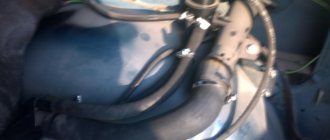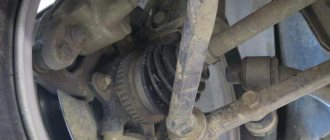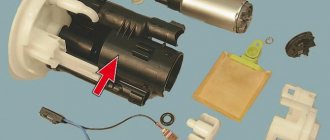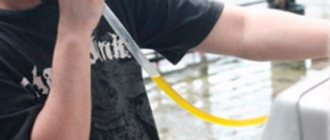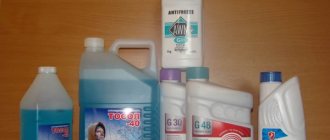Try it yourself > Hello everyone! > In the evening I parked the car near the house, with the right side on the curb. According to the gauge, there was a little more than half of the gasoline. That's how it should be. I don’t know how it is on the Priora, on the top ten the float in the right front half of the tank flops around and sometimes sticks
> This morning I sit down and the device shows a little more than a quarter. The device shows something average. As you drive, gasoline will be added
> Could the boys have crawled up and drained the gas filter from the hose? They could, it’s good that they didn’t smoke afterwards
> I bought a plastic cover with a key, after some time it began to open with a screwdriver. Chinese bullshit.
> 1. Put a contact on the hatch so that the siren would at least scream? a lot of fuss. but in general it is reasonable to integrate into the alarm system
> 2. Put a mailbox type lock on the hatch? Opens easily
> 3. I haven’t seen a metal cover with a key in stores yet. > 4. I know that you will propose to put it in paid parking. No, I suggest you try to drain it yourself, even with a hose and a used tank, or with a key from the bottom
Personally, using the trick, the first method was not possible to empty the second half of the used tank >
Sometimes, urgently, you need to drain gasoline from the car’s gas tank. The reasons for this decision may vary. For example, low-quality fuel was filled, a small amount of it is needed for operation, or some work needs to be done on the side of the fuel tank. In this article we will tell you how to drain gasoline from a Priora
Whatever the reason, you won’t be able to quickly drain gasoline the old fashioned way using a hose. The thing is that the tank neck is made in a special way and, due to its curved shape, does not allow gasoline to be pumped out using foreign objects. Of course, you can drain gasoline from the Priora’s tank by inserting a very thin hose into it and twisting it, but the process can take a long time. Therefore, it is worth talking about some more effective ways.
How to drain fuel from a gas tank with your own hands: reasons for draining, methods
As a rule, it is necessary to drain for the following reasons:
- if the car is filled with low quality gasoline. Some car enthusiasts purchase cheap fuel, not realizing how many problems there will be later, and that they will still have to spend money on new ones;
- in order to refuel the generator and thus recharge the battery;
- due to excess fuel.
Regardless of the reasons, this procedure can be performed in several ways:
- Through the filler neck.
- Through the fuel pump.
- Through the cap at the bottom of the gas tank.
Removal through the neck is easiest.
It is enough to use a hose with a diameter of 9-15 mm and a length of 2 m. Then proceed as follows:
- insert it through the neck into the tank, turning it counterclockwise;
- Install the canister as low as possible.
You can also remove the fuel pump and pump out the fuel without any problems. Dismantling is done as follows:
- recline the rear seat cushion;
- lift the mat and unscrew the screws with a Phillips screwdriver;
- disconnect the deck with electrical wires;
- remove fuel hoses;
- the pressure glass is turned away;
- then the fuel pump is removed by tilting it to the side. This is done in order not to damage the lever, because it can also move, and then inaccurate indicators of the amount of fuel in the tank will be displayed.
It is important that fuel does not simply spill out of the gas tank.
Solving a problem using a handset
A well-known and proven method is removal using a tube. This is an old “grandfather’s” method that is still relevant among car enthusiasts today. In this case, draining occurs through a tube into a volumetric container.
Today, special bulb pumps are widely used to drain gasoline. With their help, you can quickly and safely drain the required amount of fuel. In appearance it resembles a device for measuring blood pressure. If you buy it in time, you can easily drain gasoline from any car, be it a Lada Priora or a Skoda Octavia.
What else is used to drain gasoline?
You can also drain it using the fuel channel. This is done like this:
- First, the nipple, which is located at the end of the ramp, is unscrewed.
- Then a standard hose is put on the ramp, and the other end is immersed in a container.
- Next, you need to make sure that the fuel pump pumps gasoline.
It should be noted that it is necessary to resort to draining gasoline only in special cases when there is no other solution to the problem. If the work is performed poorly, the warranty period of the machine will expire. The fact is that such procedures violate warranty requirements. It is best to refuel at special gas stations and, if you need to drain it, contact a specialist. After all, only they can perform the work in such a way as not to violate warranty requirements. It is also important to monitor the amount of fuel while driving. With this approach, there will be no problems with the gas tank.
Sometimes, urgently, you need to drain gasoline from the car’s gas tank. The reasons for this decision may vary. For example, low-quality fuel was filled, a small amount of it is needed for operation, or some work needs to be done on the side of the fuel tank. In this article we will tell you how to drain gasoline from a Priora
Whatever the reason, you won’t be able to quickly drain gasoline the old fashioned way using a hose. The thing is that the tank neck is made in a special way and, due to its curved shape, does not allow gasoline to be pumped out using foreign objects.
Of course, you can drain gasoline from the Priora’s tank by inserting a very thin hose into it and twisting it, but the process can take a long time. Therefore, it is worth talking about some more effective ways.
There are several methods available that you can choose from as per your convenience.
We use pumps
Technologies do not stand still. To drain gasoline from a tank, you can use ready-made solutions - these are manual and electric pumps for pumping liquids.
Electrical devices will require 12V/24V power. They are either submersible or non-submersible. For passenger cars, the second option is suitable.
But you need to understand that there are pumps that can only pump diesel fuel, water, oils, but not gasoline. Therefore, before purchasing such a device, carefully read the instructions for it.
But for non-everyday use, it is more advisable to have hand pumps; they are much cheaper and no less effective.
Reasons for draining gasoline
To force a driver to drain fuel from a car, there must be compelling reasons. Let's consider the main ones:
- The need to repair the vehicle. This could be due to a traffic accident or planned restoration of body parts. For safety reasons, the fuel tank is removed, and then the fuel is drained.
- Cleaning the fuel system and gas tank. To clean the system, automotive chemicals are often used, and therefore it is worth removing fuel from the entire system.
- Replacing or repairing a gas tank is one of the reasons why you may need to drain the fuel.
We drain gasoline from the “classic”
How to drain gasoline from a VAZ “classic”? This is the simplest and most proven method, which was used by our grandfathers. To carry out the operation, you will need a hose that will fit into the filler neck. Beginning car enthusiasts may be faced with the question of how to drain gasoline with a hose. The operation is quite simple:
- Unscrew the filler plug.
- We insert the hose through the hole so that it reaches the bottom of the fuel tank.
- Now you need to slightly pull the air from the back of the tube toward you and sharply insert the hose into the container.
- Thus, gasoline should flow.
You should be extremely careful because you can draw in too much air along with fuel that enters the body. This can lead to the most dire consequences.
After the fuel remains at the bottom of the fuel tank, you can remove the hose and remove the container to carry out the remaining manipulations. This method was often used by thieves who drained fuel from the car at night.
How to drain gasoline from a Lada Priora
Unlike “classics”, on modern cars it is no longer possible to drain fuel through the neck of the fuel tank, since there are protections. It is simply not possible to stretch the hose inside the tank and “suck out” the fuel. Then how to drain gasoline? Other methods are used for this.
For this type of car there are two ways to solve the problem. The first option involves wedging into the fuel line in the area of the fuel filter. The second is dismantling the fuel pump. Let's look at each method step by step.
Drain gasoline through the fuel filter:
- Finding the location of the fuel cell. Usually the gas filter is located under the rear right wheel. But the location may vary depending on the year or model.
- Snap off the filter groove on the nozzle side.
- We put on a hose, which we immerse in the container.
- The fuel pump needs to be made to work. If you turn on the ignition, it will only work for a few seconds. To fool the electronics, you need to close relay K12. To do this, car enthusiasts use a jumper in the form of a wire.
The second method involves dismantling the fuel pump. There is a structural element located under the rear sofa that needs to be removed. Let's consider the sequence of operations for draining gasoline through the fuel pump:
- As already mentioned, we remove the rear sofa. There is a plug underneath that hides the fuel pump.
- Remove the protective cover and gain full access.
- Unsnap the power supply terminals. You should first turn off the power to the fuel pump. This can be done by removing the corresponding fuse in the mounting block or removing the negative terminal from the battery.
- Relieve the fuel system pressure. After this, unscrew the fuel supply pipes.
- Remove the fixing circle.
- Now you can remove the fuel pump.
- We gain access to the fuel tank. Next, we carry out the operation with the hose, as in the case of the “classic”.
When and what liquid to pour?
As you can see from the table, AvtoVAZ recommends filling in several types of oils and liquids. So let's figure out what liquid to fill and when.
Engine lubrication system
It is recommended to fill the Lada Priora engine with several types of automotive oils according to the SAE (American Association of Engineers) classification. In order to determine what kind of oil to pour into the engine, it is necessary to rely on the air temperature at which the car will be operated. The table below shows the temperature and oil used at a certain temperature.
Oil table depending on air temperature
| Outdoor temperature | SAE oil classification |
| -25 to +35℃ | 5W-40 |
| -25 to +20℃ | 5W-30 |
| -20 to +35℃ | 10W-40 |
| -20 to +30℃ | 10W-30 |
| -15 to +45℃ | 15W-40 |
Based on this table, it is necessary to select the required oil in the Lada Priora according to the degree of viscosity. The manufacturer recommends changing the engine oil no later than 15 thousand km, but it is better to change it at 10 thousand km.
Gear box
The choice of oil for the Lada Priora gearbox is based in the same way as the choice of engine oil on the ambient temperature in which the car will be operated.
Below is a table of transmission oil depending on air temperature.
Table of dependence of transmission oil on air temperature
| Outdoor temperature | SAE oil classification |
| From -26 to +45℃ | 80W-85 |
| -40 to +40℃ | 75W-90 |
AvtoVAZ recommends changing the oil in the gearbox no later than 75 thousand km, but in practice it is better to change the oil after 50 thousand km.
Engine cooling system
The manufacturer recommends adding antifreeze or antifreeze to the engine cooling system. The volume of Priora coolant is 7.9 liters. It should be noted that antifreeze is filled at the Priora plant. Under no circumstances should you ever use water as a coolant, since when the air temperature drops, the cylinder head may defrost with dire consequences and costly repairs.
Fuel tank
The Priora's fuel tank capacity is 43 liters, which is quite enough for an engine capacity of 1.6 liters. AvtoVAZ recommends using only high-octane gasoline, namely AI-95. It should be noted that on a full tank the Priora can travel from 400 to 600 km, depending on driving style.
Hydraulic Brake System
Priora is equipped with a system with hydraulic brakes and ABS. The volume of Priora brake fluid is 1 liter. DOT-4 brake fluid. It is recommended to replace brake fluid every 2-3 years, as brake fluid tends to age.
Windshield washer reservoir
The Lada Priora washer reservoir contains 2.2 liters of special liquid for cleaning the windshield from dirt. It is necessary to use a special liquid that does not freeze down to -40 degrees. During summer time, filling with ordinary water is allowed.
We hope our article was useful to you.
Other ways to drain gasoline from a vehicle
On some cars of the Lada family, where the fuel tank is located under the luggage compartment, there is a fuel drain bolt. This happened on the first generations of Priora and Granta. It served precisely so that, if necessary, fuel could be drained from the fuel tank. The procedure is quite simple: we place the container and unscrew the bolt with a 17 key. But later this mechanism was removed.
Another option is to drain through the fuel rail. First, the fuel supply hose is unscrewed and extended to drain the combustible mixture. Next, as in the case of the fuel filter, the relay closes. Fuel is being drained. In this option, it is recommended to use a longer tube so that gasoline does not get on the engine and electrical elements located in the engine compartment.
Automotive fuel
Gasoline is a mixture of hydrocarbons that has the following properties:
- highly flammable;
- mostly colorless;
- density 700-780 kg/m2;
- highly volatile and flares up at 20-40° C;
- boils at 30-200° C;
- freezes at -60° C.
To improve the quality, 0.07-0.2% additives are added to the fuel:
- Antiknock agents (monomethylaniline 15%).
- Antioxidants.
- Anti-corrosion agents for metals.
These additives are poisonous, environmentally hazardous and produce high temperatures during combustion, which can damage the car engine.
It is best to use methyl carbinol and dimethyl ketone when necessary, as they are less toxic. If you add one hundred milliliters of ethanol to one liter of AI-92 fuel, you will get AI-95, since the octane number increases.
Gasoline is obtained from oil; it has two main technical characteristics, indicated by letters and numbers:
- A – motor.
- Brand AI – research.
- The numbers 92, 95 are the percentage of isooctane with heptane.
- The octane number characterizes the resistance of gasoline to detonation. The higher the percentage, the lower the probability of failure of the cylinder-piston group of parts.
- Detonation is the arbitrary spontaneous ignition of gasoline under pressure with consequences in the form of an explosion.
AI-92:
- used to operate carburetor internal combustion engines; detonation resistant;
- ensures stable engine operation;
- is widely popular in Russia and the CIS countries;
- summer is used in the southern regions of the Russian Federation throughout the year, and in the northern regions - from 01.04 to 01.10;
- winter - in the north of the country from 01.10 to 01.04;
- 4th class according to EURO-4 standard;
- works from +60 to -35-55° C;
- stores well and for a long time;
- burns quickly and evaporates during processing.
Chemical composition:
- contains sulfur – no more than 0.05%;
- there is manganese - in 1 dm³ - 18 mg;
- resin composition per 100 cm³ – up to 5 mg;
- etiolation possible (0.15 g/l Pb);
- without etiolation (0.013 g/l);
- can boil at 33-205° C;
- There is no more than 5% benzene;
- p at 15 °C kg/ – 725-780;
- clear liquid.
Conclusion
How to drain gasoline from a car? It’s quite simple if you know all the subtleties and nuances, as well as the design of the fuel system. Of course, you will need additional materials, such as a set of keys or a hose, as well as knowledge of the car.
In the life of car enthusiasts, in some cases there is a need to urgently drain gasoline from the tank. For example, when the wrong gasoline was poured into the tank, or the quality of the fuel is very poor, or the gasoline needs to be drained to repair the fuel system. We offer you several simple ways to drain gasoline from the tank of a modern car.
The essence of the problem is that if draining fuel from the tanks of old domestic cars and foreign cars does not cause difficulties, then, for example, in modern VAZ models with an injector, a special filter mesh located in the filler neck of the gas tank prevents draining gasoline. This mesh serves not only as a filter, but also as a good protection against thieves, preventing a hose from being inserted into the tank through the neck and draining gasoline.
Most often, the need to drain gasoline from the tank occurs in the following foreign cars and VAZ cars:
- Renault Logan, Ford Focus, Chevrolet Lanos and Niva;
- Lada: Granta, Kalina, Priora;
- VAZ: 2109, 2110, 2114 and 2115.
For a visual video on how to drain gasoline from the tank of a VAZ car with an injector, see the end of the article.
What Oil to Pour into Kalina for the Winter ~ AUTOINTERLINE.RU
This is the first thing a new car owner has to deal with. This is to find out what technical water is poured into the machine and how soon it should be changed. The engine is considered the main unit, so in most cases they start with engine oil.
Let us remind you that AvtoVAZ installs it on its models, so the advice on what oil to pour into the engine will be similar for all modern Lada cars (Granta, Priora, Kalina, Largus, Niva, Vesta or XRAY). We select Niva 4x4 engine oil in.
What motor oils are recommended by AvtoVAZ? If you open the Administration for the Operation of a Vehicle and Its Modifications, not the latest edition, you can find Table 2 “Motor Oils”. Comparing them for different Lada cars, you can realize that AvtoVAZ recommends similar motor oils for Lada Granta/Kalina/Priora engines.
THIS IS INTERESTING: Installing xenon Mazda 6
For Lada Vesta, AvtoVAZ recommends using Rosneft brand motor oil, API class SL, SM or SN. What brand of oil does the Lada come from the factory? From time to time, information about the filled engine oil is indicated on a tag under the hood. In most cases, AvtoVAZ fills with Lukoil semi-synthetic/mineral motor oil. During maintenance, the manufacturer fills in ROSNEFT 5W-30 motor oil (semi-synthetic).
You can top up with ROSNEFT Premium or ROSNEFT Maximum 5W-40 or 10W-40.
Find the viscosity of motor oil How to find the composition of motor oil? To answer this question, we conducted surveys among the owners of Lada Grant, Lada Kalina and Lada Priora, asking them to answer the question “What oil composition do you use in your own car?” and in the end we received approximately similar results:
What kind of oil should I use? why I like Lukoil and not like Shell
Which company should I use the oil for?
The survey below will help you decide on the choice of engine oil. Participate in our survey and discussions. Let us remind you that the website also contains advice on viscosity and composition. By the way, the HR16 engine is also installed on the Lada Vesta; read tips on choosing lubricants for it. For Lada Largus with Renault K4M or K7M engine.
The service life and service life of both the engine and the gearbox depend on the lubricants used in the car. Nowadays, practically no one has problems with fuel and lubricants; the main thing is not to run into a fake.
After all, even the most ordinary and cheap oils, such as Lukoil semi-synthetic, are completely justified and engines run on it for more than 300,000 km without long repairs, tested from personal experience.
And below there will be another table that will help you decide on the choice for your weather conditions We have already figured out the oils for Lada Kalina engines, now we will look at the transmission ones below, for gearboxes. I would also like to note that the manufacturer strongly advises against using additional additives for both engine and and for transmission oils, since modern fuels and lubricants already have all the necessary components for the flawless operation of all components and assemblies. From personal experience I can say that I filled my Kalina with ZIC A semi-synthetic, and the TNK Magnum gearbox is also semi-synthetic.
After removing the valve cover, I turned my attention to the condition of the camshaft, everything was impeccably clean, there was no waste at all. From shift to shift the level on the dipstick was the same
The motor runs quietly, there are no vibrations, in general I am satisfied.
As for the gearbox, after the TNK there was only a little less extraneous sound, well, that may be self-hypnosis, but at low temperatures the gears became more noticeable and easier to engage. Here, for example, is the appearance of the engine after 40,000 km of operation with ZIC A oil. In this photo, the oil is already ready for replacement, but it is clear that there are no deposits or deposits, one can say that everything is impeccably clean.
The only thing that pushed me to buy ZIC was the iron canister, which leaves little hope that what’s inside is original and not a fake.
Ways to drain gasoline from the tank of a foreign car
If your car has a mesh installed in the gas tank, and you can’t drain the gasoline with a hose, don’t worry. There are several other simple ways to drain fuel from the gas tank of a foreign car.
In any case, it is worth remembering that gasoline should only be drained from the tank in an open area, so as not to be poisoned by fuel vapors, which are very harmful to human health.
Method 1
Many modern cars have a special drain hole at the bottom of the gas tank that allows you to completely drain all the fuel from the tank. You just need to find this hole, place a suitable container under it and, unscrewing the cap, pour gasoline into it.
This method is very simple, but not all cars have drain holes, and crawling under the car is not always convenient. Therefore, we will consider another option, how to drain gasoline from the tank of a foreign car.
Method 2
In order to drain gasoline from the tank of a foreign car, you need to perform a few simple steps:
- Open the hood of your car;
- With the engine off, disconnect the fuel hose (coming from the fuel pump) at its connection to the engine.
- Place the freed end of the hose into a suitable container for draining gasoline from the tank (bottle, canister, etc.).
- Turn on the car's ignition, but DO NOT START the engine! In this case, the fuel pump will turn on for a few seconds and pump fuel. Thus, by turning the ignition on and off several times, you can drain a sufficient amount of gasoline from the fuel tank.
- After you have drained the required amount of gasoline, the fuel hose should be reconnected to the engine.
Keep in mind that it is better not to drain all the gasoline from the tank in this way, so as not to damage the fuel pump and not to choke the fuel system of the car.
By the way, on some injection engines of modern foreign cars and cars of the VAZ family, the manufacturer has provided a special fitting that allows you to drain gasoline from the tank without disconnecting the fuel hose from the injector (see the example in the video below).
Domestic cars
VAZ 2110/2112/2114/ 16 valves injector
The methods listed below are also suitable for those cars where there is a protective mesh in the fuel neck.
You need to drain gasoline on a cold engine.
- connector for connecting to the fuel pump (sold separately) and a wire to it up to 3 meters long.
- a hose up to 3 meters long and with a diameter suitable for the fuel pump fitting.
- clamp;
- two crocodiles for connecting to the battery;
- metal canister;
- rags.
- Fold down the two rear seats and unscrew the fuel pump access flap.
- Disconnect the wire connector.
- Relieve pressure in the system. To do this, remove the engine protective cover. Find the special fitting (it is shown in the photo below) and release the pressure by pressing the button. To prevent fuel from spilling, place a small container with a volume of up to 0.5 liters.
- Find the gasoline supply hose on the pump; as a rule, it is single. Double return hose. Follow the arrow on the pump cover.
- By pressing the bracket, remove the fuel supply hose.
- Connect the prepared hose to the fitting and secure it with a clamp. Place its other end into the prepared container.
- Connect a pre-prepared connector to the pump by first extending its wire to 3 meters.
- Remember where the positive and negative wires are located and use alligator clips to connect them to the battery. Plus to plus, minus to minus.
- Gasoline will begin to flow into the container.
- Reverse the steps to return everything to its original position. Please note, do not rush to remove the hose from the canister. First, disconnect it from the fitting and drain the remaining gasoline.
Similar to the first one, only we disconnect the hose in front near the engine:
- To the right of the engine near the exhaust manifold, find the fuel supply hose. It releases easily thanks to the spring latches. The disconnect location is shown in the diagram below.
- Connect to it a pre-prepared hose at least 3 meters long. Place the other end into a metal container.
- Turn on the ignition. The pump will start working and pump out fuel. It is not recommended to start the car as the pump may fail.
About 100 - 150 ml of gasoline will drain at a time. Next, turn off the ignition and turn it on again.
Suitable for injection vehicles VAZ 2110, 2112, 2114, Lada Granta. We also take a hose and container.
- Remove the fuel pressure valve cap and use a regular cap to unscrew the nipple.
- Insert the hose. We lower its second end into the canister.
- Turn on the ignition. While the pump is pumping, gasoline will drain.
- We repeat the procedure until we add the required amount of fuel.
Methods 2 and 3 are not suitable for situations where you need to completely drain the gasoline. Frequently turning the ignition on and off will quickly drain the battery, and if you start the car, there is a high probability that the pump will idle and burn out.
On the Lada Granta we also find a fitting for measuring pressure, it is located in the same place as on the VAZ 2110. All operations are performed in the same way.
Alternatively, you can use the following method.
The hose is connected using the methods already described above or directly to the fuel rail.
We find the fuel pump relay and close the contacts on it. On 2112, 2111, 2110 the relay is located below to the right of the driver.


